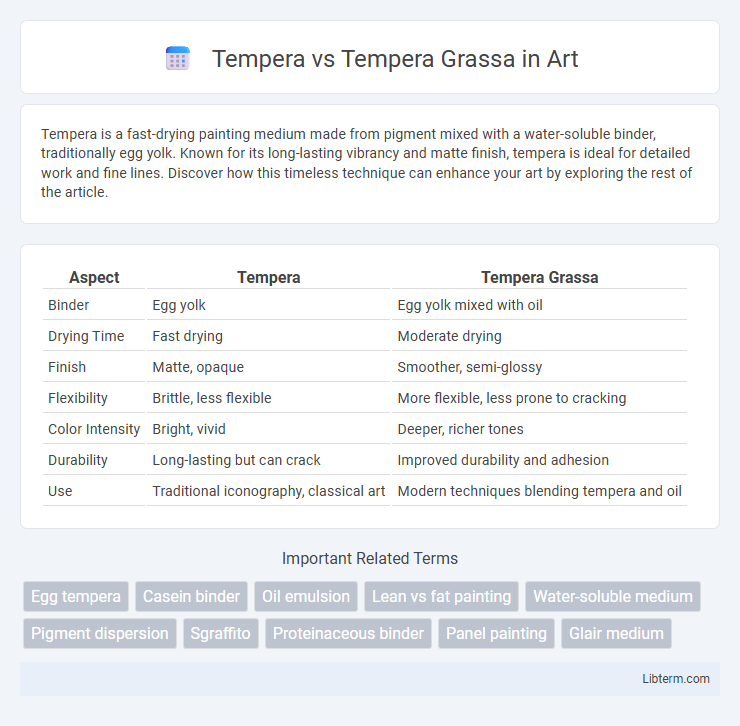Tempera is a fast-drying painting medium made from pigment mixed with a water-soluble binder, traditionally egg yolk. Known for its long-lasting vibrancy and matte finish, tempera is ideal for detailed work and fine lines. Discover how this timeless technique can enhance your art by exploring the rest of the article.
Table of Comparison
| Aspect | Tempera | Tempera Grassa |
|---|---|---|
| Binder | Egg yolk | Egg yolk mixed with oil |
| Drying Time | Fast drying | Moderate drying |
| Finish | Matte, opaque | Smoother, semi-glossy |
| Flexibility | Brittle, less flexible | More flexible, less prone to cracking |
| Color Intensity | Bright, vivid | Deeper, richer tones |
| Durability | Long-lasting but can crack | Improved durability and adhesion |
| Use | Traditional iconography, classical art | Modern techniques blending tempera and oil |
Introduction to Tempera and Tempera Grassa
Tempera is a traditional painting medium made by mixing pigment with a water-soluble binder, typically egg yolk, resulting in fast-drying, matte finishes favored in early Renaissance art. Tempera grassa enhances traditional tempera by incorporating a fatty binder, such as oil or wax, creating richer textures and increased flexibility while retaining tempera's characteristic luminosity. Both mediums offer distinct advantages in durability and visual effect, with tempera grassa bridging classical tempera's fine detail capacity and oil painting's richness.
Historical Background of Both Techniques
Tempera, dating back to ancient Egypt and flourishing during the Italian Renaissance, utilized egg yolk as a binder for pigments, creating fast-drying and durable paint favored by early masters like Giotto and Botticelli. Tempera grassa, an evolution developed in the 15th and 16th centuries, incorporated oil or fat into the traditional egg yolk medium, enhancing flexibility and richness of color while maintaining tempera's quick-drying properties. This hybrid technique bridged medieval tempera and oil painting, marking a key transition in art history toward more versatile and texturally complex works.
Key Ingredients and Composition Differences
Tempera paint primarily uses egg yolk as a binding medium, mixed with water and natural pigments, resulting in a fast-drying, matte finish with excellent durability. Tempera grassa differs by incorporating oil, such as linseed oil, into the egg yolk mixture, enhancing the paint's flexibility, gloss, and drying time. The key compositional difference lies in the addition of oil to tempera grassa, creating a paint that combines the translucency of tempera with the richer texture and extended working time of oil painting.
Application Methods: Tempera vs Tempera Grassa
Tempera paint, composed of pigment mixed with egg yolk, applies quickly in thin, opaque layers with rapid drying, ideal for fine detail work. Tempera grassa incorporates oil or fat into the traditional egg yolk binder, resulting in a longer drying time and a smoother, more versatile application, allowing for blending and richer textures. Artists leverage tempera for precise, matte finishes, while tempera grassa enables a semi-gloss surface with enhanced flexibility in brushwork and layering techniques.
Drying Time and Workability
Tempera dries quickly, typically within minutes to an hour, allowing for rapid layering but limiting blending time. Tempera grassa, enriched with oil, has a longer drying time, ranging from several hours to a day, enhancing workability and enabling smoother gradients. The extended drying period of tempera grassa makes it ideal for artists seeking more flexibility in mixing and detail refinement.
Visual Characteristics and Texture
Tempera paint dries to a matte, opaque finish with fine, crisp details, emphasizing flat, smooth textures ideal for detailed and delicate artwork. Tempera Grassa, enriched with oils, offers a glossier surface and richer color depth, producing a smoother texture with subtle tonal transitions and increased luminosity. The added oil content in Tempera Grassa enhances flexibility and blending capabilities, resulting in more vibrant and tactile visual effects compared to traditional tempera.
Durability and Longevity of the Paintings
Tempera paint offers excellent archival quality due to its quick drying time and resistance to cracking, ensuring long-term durability in artworks. Tempera grassa, which incorporates oil into traditional egg tempera, enhances flexibility and water resistance, reducing the risk of brittleness and extending the painting's longevity. The addition of oil in tempera grassa provides a more resilient film compared to classic tempera, making it better suited for preserved surfaces in varied environmental conditions.
Common Artistic Uses and Themes
Tempera is widely used for its fast-drying properties and vibrant, matte finish, making it ideal for detailed panel paintings and traditional iconography. Tempera grassa, distinguished by its added oil content, offers increased flexibility and richer textures, which artists favor for more expressive brushwork and layered glazes in portraiture and still life. Both mediums excel in precise detail, but tempera grassa's enhanced durability supports larger-scale works with dynamic lighting and depth.
Advantages and Limitations of Each Medium
Tempera offers fast drying times and excellent color permanence, making it ideal for detailed, layered artwork, but it lacks flexibility and can crack if applied thickly. Tempera grassa combines traditional tempera pigments with added oil, providing increased flexibility, richer textures, and enhanced blending capabilities, yet it requires longer drying periods and careful handling to avoid dirt pickup. Both mediums excel in vibrancy and durability, but tempera suits crisp, matte finishes while tempera grassa benefits artists seeking a more luminous and viscous paint.
Choosing Between Tempera and Tempera Grassa
Choosing between tempera and tempera grassa depends on the desired texture and finish of the artwork. Tempera, made with pigment and egg yolk, offers a matte, fast-drying surface ideal for fine detail and crisp lines. Tempera grassa incorporates oil with egg yolk, resulting in a richer, more flexible paint that provides a glossy finish and enhanced color depth, suitable for more expressive and layered techniques.
Tempera Infographic

 libterm.com
libterm.com